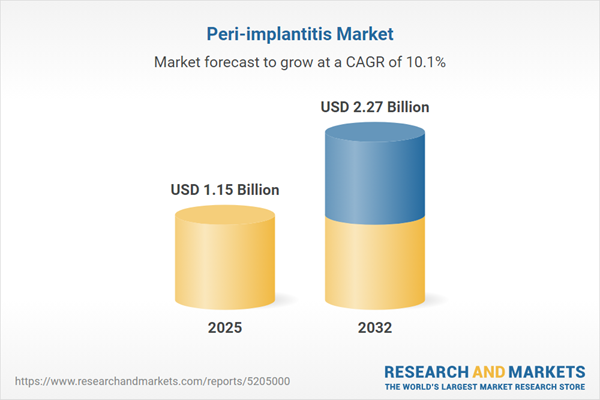Speak directly to the analyst to clarify any post sales queries you may have.
The peri-implantitis market is evolving rapidly as organizations address shifting compliance requirements, updated clinical protocols, and rising expectations for clear, measurable outcomes. Senior executives focused on dental healthcare must stay alert to these trends to drive strategic advantage and operational agility.
Market Snapshot: Peri-Implantitis Market Size and Growth
Strong and steady market expansion characterizes the peri-implantitis sector, reflecting intensified investments in improving implant longevity and new clinical technologies. Sophisticated imaging systems and advanced regenerative materials are prompting a paradigm shift in both patient care and underlying business processes. The current regulatory atmosphere continues to escalate, with heightened compliance demands motivating providers to develop rigorous process controls and pursue higher operational efficiency. As these forces converge, organizations across the peri-implantitis landscape are adapting their strategies and capabilities to navigate ongoing innovation and shifting clinical expectations.
Scope & Segmentation in the Peri-Implantitis Market
Effective segmentation allows dental organizations to serve distinct clinical and operational needs while supporting expansion across key regions and technologies.
- Product Type: Adjunctive devices, pharmaceutical therapies, laser systems, various membrane products, and surgical materials enable flexible protocols that adapt to diverse patient profiles and treatment scenarios.
- Treatment Modality: Options such as non-surgical decontamination, localized antimicrobials, and a range of surgical interventions—both regenerative and resective—address site-specific and practice-driven requirements.
- End User: Dental clinics, hospitals, and ambulatory surgery centers operate with unique workflows, calling for tailored supply, procurement, and inventory management strategies.
- Distribution Channel: Direct sales, distributor networks, and digital platforms provide scalable and responsive access to peri-implantitis solutions, supporting quick turnaround and efficiency at the point of care.
- Implant Material: Titanium and zirconia maintain their role as core implant materials, aligned with the latest in clinical guidance and material science progress.
- Severity: Patient stratification from mild to severe cases structures both intervention focus and allocation of resources across treatment environments.
- Geographic Regions: Geographic focus spans the Americas, Europe, Middle East & Africa, and Asia-Pacific, with strategies shaped by local regulations, adoption trends, and supply chain factors.
- Key Companies: Industry leaders, including Institut Straumann AG, DENTSPLY SIRONA Inc., Zimmer Biomet Holdings, and Nobel Biocare Services AG, set standards in clinical performance and ongoing innovation.
Key Takeaways: Strategic Insights for Senior Leaders
- Advanced imaging and biomarker technologies are enabling earlier detection and more precise diagnosis of peri-implantitis, positioning clinical teams to make data-driven, patient-focused decisions.
- The integration of adjunctive modalities with regenerative materials streamlines the delivery of consistent care across varied case complexities and promotes protocol standardization.
- Adopting digital workflows throughout clinical environments supports better resource allocation, minimizes operational delays, and enhances the quality of patient management.
- Ongoing professional development and participation in regional networks foster readiness to address regulatory changes and evolving patient demands.
- Continued innovation in implant material science aligns with new clinical standards, ensuring compliance and supporting systematic, analytical planning within organizations of all sizes.
Tariff Impact on the Peri-Implantitis Treatment Value Chain
Recent changes to U.S. tariffs have prompted stakeholders to review cost structures and enhance their supply chain resilience. Market leaders are instituting scenario-based planning, expanding supplier portfolios, and applying advanced risk management protocols to ensure reliable care delivery. These adjustments help to counterbalance the economic effects of external pressures and maintain business continuity in peri-implantitis treatment operations.
Methodology & Data Sources
This report draws on structured interviews with oral health professionals alongside insights from supply chain analysts. Peer-reviewed literature and curated industry data reinforce the findings, offering an accurate assessment of current market dynamics and operational trends.
Why This Report Matters
- Delivers actionable insights for senior leaders to navigate regulatory complexities and accelerate clinical innovation in the peri-implantitis market.
- Provides robust segmentation and peer benchmarking, enabling agile planning and targeted adaptation to diverse operating environments and regions.
- Empowers decision-makers to build strategies that reinforce organizational preparedness and responsiveness across the dental health value chain.
Conclusion
This analysis supports executives with evidence-based perspectives and practical strategies for tackling emerging market trends, equipping organizations for successful adaptation and resilient positioning within the evolving peri-implantitis landscape.
Additional Product Information:
- Purchase of this report includes 1 year online access with quarterly updates.
- This report can be updated on request. Please contact our Customer Experience team using the Ask a Question widget on our website.
Table of Contents
3. Executive Summary
4. Market Overview
7. Cumulative Impact of Artificial Intelligence 2025
Companies Mentioned
The companies profiled in this Peri-implantitis market report include:- Institut Straumann AG
- DENTSPLY SIRONA Inc.
- Zimmer Biomet Holdings, Inc.
- Nobel Biocare Services AG
- Osstem Implant Co., Ltd.
- MIS Implants Technologies Ltd.
- Geistlich Pharma AG
- BioHorizons IPH, Inc.
- CAMLOG Biotechnologies GmbH
- Osteogenics Biomedical, Inc.
Table Information
| Report Attribute | Details |
|---|---|
| No. of Pages | 182 |
| Published | October 2025 |
| Forecast Period | 2025 - 2032 |
| Estimated Market Value ( USD | $ 1.15 Billion |
| Forecasted Market Value ( USD | $ 2.27 Billion |
| Compound Annual Growth Rate | 10.1% |
| Regions Covered | Global |
| No. of Companies Mentioned | 11 |









